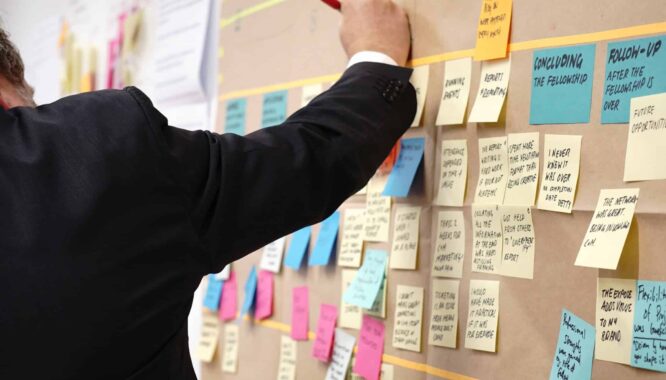
In 2001, The Agile Manifesto was developed by the Agile Alliance who introduced four agile values and twelve agile principles for agile software development. Practitioners have been applying an agile approach long before this, but this was the first concrete document that solidified the agile framework for the entire industry to adopt. Since then, many other business functions (project management, manufacturing, data management, etc..) have adopted agile processes as well.
If there is one thing the pandemic drove home was that businesses need to be able to rapidly respond to change. For the HR function, this means becoming more agile as well. HR needs to adapt systems and processes to new work environments, different expectations for employee experience and rapidly changing business conditions or models. Business does not stand still, and neither should HR. Businesses are breaking away from the traditional approach to HR and becoming more and more agile. That is why agile HR is a must-have capability for HR technology today.
Related articles:
Digital Leadership in HR: Transform your Management System
Digital Workplace: The Future of our Work Environment
What is Agile HR?
It may seem intimidating at first. You may have heard the words Scrum and Kanban used by the tech gurus especially in terms of software development. But we don’t need fancy frameworks to describe the agile methodology. Put simply, it is delivering value to your customers through
- continuous improvement
- effective communication
- simplicity
- working software
For HR leaders, this can have several implications. Essentially, it is their responsibility to drive agile transformation among their teams as well as across the organization. This means that HR must adopt not only agile methodologies that allows them to respond quickly to change, but also a mindset of continuous delivery. At the same time, they need to have the technology and tools at hand that support this mindset and are capable of fostering cross-functional collaboration and delivering an enhanced employee experience.
Applying Agile Principles to your HR Technology
Applying agile principles to your HR technology does not mean you need to go out and become a Scrum master tomorrow; it can be much simpler than that. It’s about the high-level mindset that you apply to every aspect of the business and how you leverage these principles to drive important business outcomes.
Agile means you can do things faster, better and cheaper
If you already have systems, you can connect them and create a unified employee experience in a matter of weeks instead of several months or years, which is the time it normally takes to implement an entirely new HR ecosystem. This is the HR platform approach. The beauty of this approach is that instead of starting with a database someone else designed, you start with what you want the end user experience to be and work backwards.
Very quickly you are delivering value to employees and managers without spending painful months setting up data, integrations, workflows and such. You can produce a unified employee experience where all digital interactions within a company can be in one place. Applications, surveys, communications, workflows are all accessible to your entire workforce. The learning curve is almost flat and you save time and money on training users on new tools.
The bonus is that you save money in other surprising ways. First, you don’t pay extra for features you don’t need. You can pick the level of functionality you need and from which vendor. You may not need a vendor at all in some cases as you can create your own dashboards and workflows in the platform. Secondly, you don’t have to spend time and money integrating systems to each other because you can connect them all to the platform just one time. Finally, you are insulated from price increases because if one vendor costs too much they know you can switch to another vendor to bring the price down.
How much can you save? Let’s look at a real-world example of a 1,000 person company. This company was quoted from one of the big HR suites $450,000. The customer’s concern was getting locked into one vendor. They choose to go with a platform. The end result? By eliminating feature bloat and expensive integrations, the organization was able to bring the price down to $300,000 and provide a fantastic employee experience without any fear of being hit by a big bill if they wanted to change something in the future.
How are HR teams becoming agile teams?
For HR, the need to respond to change has always been present, but the tools to adapt have not. Despite billions being spent on HR technology, less than half of companies say HR technology has made HR more strategic. Only 11% of companies say HR technology improves the employee experience. These numbers are discouraging.
Can you think of any product that you would purchase if you knew it fails more than 50% of the time?
We are not advocating for yet another application, but instead for the adoption of an entirely new way to think about HR technology. We believe the first step in becoming an agile business function is to break the dependence on a single vendor. To do this, human resources should adopt a new type of technology known as a people experience platform.
While a lot of vendors call themselves a platform, the truth is they are really just monolithic applications which want to sell you add-ons. Perhaps this is why so many “platforms” have noncompetition and other restrictive clauses in their fine print.
Don’t believe us? Ask any of the big HR marketplaces if you could use their “platform” while at the same time use a competing product to their core offering, e.g. payroll. For a little fun, try searching for a payroll system on a payroll vendor’s marketplace. Let us know what you find.
4 ways you can tell the difference between an agile HR platform and vendors disguised as a platform
A true HR platform is designed to maximize, not restrict choice. It has four defining characteristics:
- An HR platform is vendor independent. No one vendor controls what or who is on the platform. That is because that decision is made by the customer.
- An HR platform is built on connecting technologies whose purpose is not to trap you into some vendor ecosystem but to allow the customer to choose among the thousands of applications, HR and non-HR, that exist in the HR tech market today and in the future.
- An HR platform works across multiple applications. It can report and execute workflows using data that come from multiple sources.
- An HR platform is compatible across work environments. This means it will work on the employee’s device of choice and in the language the employee prefers to use.
Since an HR platform is not in and of itself an HRIS or anther HR tool, the good news is that an HR platform can be implemented without having to rip and replace existing investments. Instead, the platform can be used to consolidate multiple applications into a single unified employee experience. From there, HR can keep what it wants, eliminate redundancies and add new functionality.
It’s time to for HR to break up with big application vendors and embrace an agile HR platform
Embracing the Mindset to be Agile, Independent, and Impactful
As seen in the example above, HR has the ability to make a significant positive impact on a business. We also saw this during the pandemic when HR stepped up and helped create new working environments, managed ever evolving work restrictions, and helped employees navigate a hugely stressful situation.
Now HR has the opportunity to continue focusing on the employee in non-pandemic times. Advances in integration technology have given HR, for the first time, a platform with inherent business agility. The old HR was about administering processes in someone else’s idea of an HR system. The new HR is agile, independent and impactful. It is empowered and enabled to design the best experience for its employees.
Continuous Improvement
As agile practices become part of your company culture, so will the continuous improvement approach. This will apply to each part of the employee lifecycle as you experiment and continue to evaluate each initiative or software that is put in place. Deploying an HR platform approach allows for the flexibility to quickly switch out what is not working and the ability to introduce incremental changes.
There are many resources that can be used to evaluate your HR tech stack on a regular basis. These include but are not limited to user-stories, stakeholder feedback and real-time KPI reporting.
Redefine the Employee Experience
One of the most impactful elements of agile HR and its supporting agile software is redesigning the employee experience to support high business performance and drive business value. In fact, this approach invites employees to contribute to the improvement of their own work experience and development.
Regular Feedback
You should never assume that you know how employees are feeling and what they are experiencing. Prioritizing regular feedback from employees, especially at critical points of the employee experience, is essential for transforming the experience of work. This could include the day-to-day work of an individual, a new HR policy, company culture initiatives or system implementations. When you get employees involved, they are empowered to impact their own quality of work life and are more satisfied and more productive as a result. This is a shift away from the traditional HR practice which evaluates HR processes once a year (or even less often).
As part of your agile tech stack, having a tool that allows you to set up feedback loops simply and regularly will be invaluable especially in a mobile workforce era.
Improved Team Collaboration
Agile methods naturally foster more collaboration including that among cross functional teams. The 12 principles include three principles that are dedicated to teamwork and communication. This is done through:
- Working together daily throughout the project
- Motivating individuals and providing them with the environment and support they need to get their job done
- Conveying information among team members through face-to-face conversation
Adopting these principles encourages teams to collaborate and support each other throughout their various projects and initiatives.
Conclusion
Every business is different and has different requirements, which is why a one-size-fits all approach does not work. In addition, deploying large systems that cost a lot of time and money does not allow your business grow in an agile way. Software projects in HR set an important foundation for how the department functions in all other areas of HR. For this reason, HR leaders need to be aware of the impact that the systems they select have on the employee experience.
We’d love to help make your ideas for a great employee experience a reality. To learn more about our People Experience platform please contact us.


-360x360.jpg)


